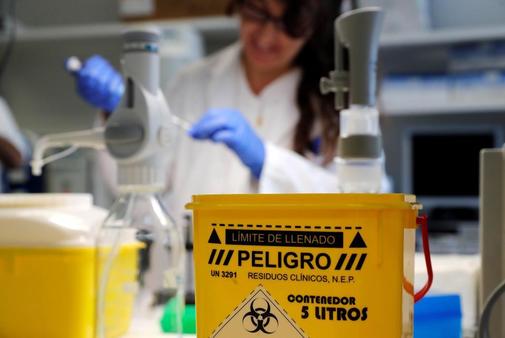- Cases: New health alert for listeriosis due to the consumption of Chicharrón de Málaga
- Listeria: The threat that survives in your fridge grows
The work that Julio Vázquez and his team do in the Listeria Laboratory of the National Center for Microbiology is reminiscent of an episode of 'CSI'. As in the police series, these professionals study biological samples , analyze 'DNA' sequences and look for possible matches that help identify the 'culprit'.
The difference is that the usual suspects they face are not bloodthirsty criminals, but pathogens such as Listeria monocytogenes , the bacterium that since August keeps health authorities on alert for an outbreak that already affects more than 200 people in Andalusia .
Its work as a state reference center is being fundamental not only to identify the origin of the infection, but also to trace the evolution of the outbreak and monitor its dimensions.
To date, they have sequenced the DNA of 170 samples from Andalusia and have been able to establish a direct relationship with the outbreak in 144 clinical cases , 13 food and a surface sample.
"Genomic sequencing has allowed us to quickly and efficiently characterize the outbreak," explains Vázquez, who emphasizes that having that particular genetic footprint of each sample allows comparing strains and knowing if the bacteria found in the facilities of the factory where the plant began. infection are the same as those isolated in patients.
It allows to draw a map; "It is a particularly useful technique in outbreaks of food infection such as this because it makes it possible to link cases with the same origin," adds Raquel Abad, one of the researchers who has studied the outbreak more closely from her poyata.
Abad knows very well the peculiarities of a bacterium that, although most of the time it does not give problems, it can cause serious complications and even death in pregnant women, babies, the elderly and people with a weakened immune system.
Thorough analysis
Since a sample arrives at the luminous facilities that the laboratory has in Madrid until the 'DNI' of that bacterium can be established "it happens around a week," says Abad, who explains that behind that deadline there is a thorough work.
First, the isolated strain is grown to have enough material to work with . Then, fragments of their DNA are extracted. And then, that DNA is introduced into a massive sequencer, a machine capable of unraveling the only chromosome that the bacteria has, showing the particularities of all its genes.
"You can sequence hundreds of samples at the same time," explains Ángel Zaballos, head of the Genomics Unit of the National Center for Microbiology. However, the data that it throws after 29 hours of analysis does not, contrary to what the television series show , an immediate test of whether that particular pathogen is an old acquaintance of researchers.
"We have to assemble all that information it gives us. Go placing it as if it were a puzzle, to know what the characteristics of that bacterium are and if they coincide with other samples analyzed. That takes a long time and we can do it thanks to bioinformatics," he adds .
Normally, this equipment - which also works with other microorganisms - receives between 200 and 300 annual samples of listeria to analyze, but this year will far exceed expectations. In their database, which they maintain since 2015, they have already sequenced more than 700 strains, most of them from patients.
This relationship is not only available to Spanish researchers, Vázquez emphasizes, but is shared with the European Center for Disease Control (ECDC) since, in an increasingly global world, outbreaks are common to cross borders.
According to data from the Spanish Agency for Consumer Affairs, Food Safety and Nutrition (AECOSAN), in 2017 there were almost 2,500 severe cases of listeriosis in humans in the European Union, with 227 deaths reported in 16 countries. In Spain, in 2018, 432 cases were notified, of which 24 ended with the death of the patient.
Recently, a study by the Carlos III Health Institute and the Ramón y Cajal Hospital in Madrid showed that in recent years, hospital admissions associated with listeriosis have increased, a fact that Vázquez attributes mainly to the aging of the population.
"The listeria has jumped to the media this summer, but it is not new . This laboratory has been monitoring and studying outbreaks for more than 30 years, even when they were little known in Spain and more frequent in countries like France," says Vázquez.
"At the beginning it was more complicated. As in Finding Wally , we had to find a special characteristic in the bacteria that, like the red and white striped sweater of the character, led us to find coincidences," recalls the researcher. "Now, genetic sequencing allows us to be much faster and more effective. It shows us much more clearly where it is and how it is what we are looking for."
According to the criteria of The Trust Project
Know more- Science and Health
HealthIndia plans to ban electronic cigarettes and penalize their use with jail
Sanitary Alert Detects batches of shredded meat contaminated with listeria packaged in June
Public health WHO ensures that malaria can be eradicated, but the first objective is to control it

